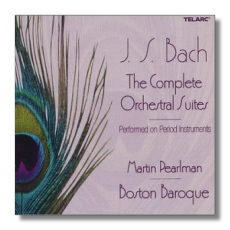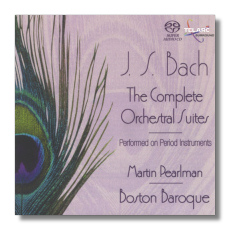
The Internet's Premier Classical Music Source
Related Links
- J.S. Bach Reviews
- Latest Reviews
- More Reviews
-
By Composer
-
Collections
DVD & Blu-ray
Books
Concert Reviews
Articles/Interviews
Software
Audio
Search Amazon
Recommended Links
Site News
 CD Review
CD Review
Johann Sebastian Bach

The Four Orchestral Suites
- Suite #1 in C Major, BWV 1066 (1725)
- Suite #2 in B minor, BWV 1067 (1739)
- Suite #3 in D Major, BWV 1068 (1730)
- Suite #4 in D Major, BWV 1069 (1725)
Boston Baroque/ Martin Pearlman
Telarc CD-80619 DDD 73:32
Also released on Hybrid Multichannel SACD SACD-60619
Amazon
- UK
- Germany
- Canada
- France
- Japan
- ArkivMusic
- CD Universe
Pearlman and Boston Baroque now have over a dozen Telarc recordings to their credit. There is a focus on opera and choral works, and a surprising lack of attention to the basic Baroque and early Classical repertoire, for which they are so well suited. In other words, it has taken Boston Baroque an awfully long time to get around to making this CD, but now that they have done so, the results are predictably satisfying.
Boston Baroque is a "period instruments" ensemble, which means that the musicians are playing instruments that could have been played around the time of Bach, or else modern copies of those same instruments. In the early days of period instruments, scholarship sometimes outstripped musicianship, and there was many a player who didn't seem to be quite in control of his or her instrument. Much has changed in the past thirty years, however, and a casual listener might be surprised to learn that modern instruments were not being used on this CD – the differences are much more subtle than they used to be. On this recording, there are nine violins, three violas, three cellos, a double bass, one flute, three oboes, one bassoon, three trumpets, a set of timpani, and a harpsichord. Sometimes much larger symphony orchestras have played these suites but there's nothing scrawny about the sound of Boston Baroque.
Pearlman's interpretations are very uncontroversial. He is not a revisionist conductor like Harnoncourt, and there's nothing of the borderline outrageousness that sometimes comes to the surface in performances of ensembles such as Musica Antiqua Köln. Critics are split on Boston Baroque. Some find their playing bland, others call them a first choice among period instruments ensembles. Pearlman makes the music sound warm and familiar, like a favorite slipper. If objectivity is your top priority, then Pearlman and Boston Baroque will give you exactly that. If you're looking for musicians who will surprise you and make Bach's music sound new, look elsewhere. Both paths are valid. Recorded in Mechanics Hall in Worcester, Massachusetts, Boston Baroque gets ideal sound from Telarc's engineers.
The Fourth Suite is played first, then the First, then the Third, and finally the Second Suite, the most famous of the four. The reason for this odd ordering is explained in Pearlman's booklet notes: modern musicology has established that this probably is the order in which they were composed, and so it was Pearlman's intention to maintain their approximate chronological order.
Copyright © 2004, Raymond Tuttle





















